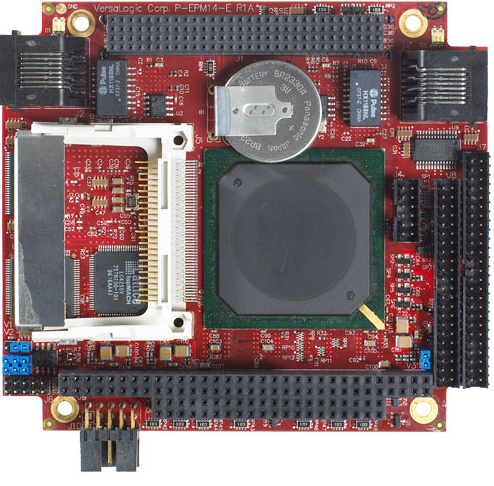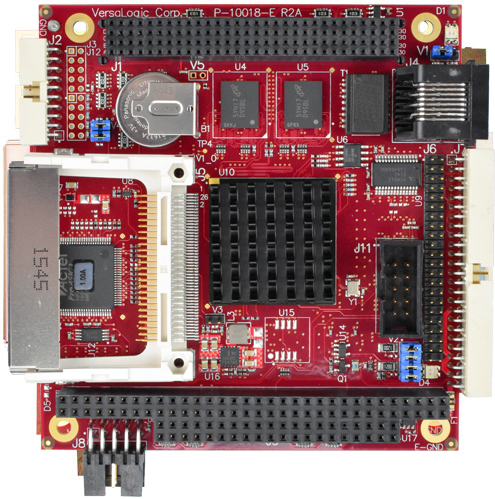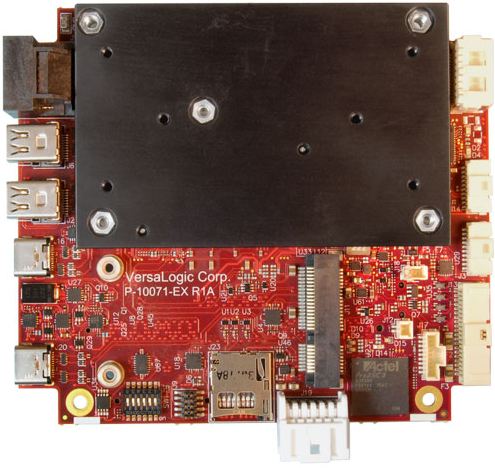The history of PC/104 single-board computers dates back to 1987. More than 30 years later, why are we still talking about this technology in 2020? Especially since electronic technology is advancing every year. However, in markets such as healthcare or defense, you still want to use products that are stable, reliable, flexible, scalable, rugged and have a long (more than 10 years) product life cycle support. This is why PC/104 is still used today.
PC/104 is stackable, rugged, compact, and familiar, but we’ve rounded up the top five:
1 – Rugged and reliable
PC/104 was first introduced in the mid-80s and quickly became widely adopted as the standard for industrial rugged computers. Unlike the Raspberry Pi and Arduino, PC/104 is designed to operate reliably in temperatures from -40° to +85°C and withstand shock and vibration to MIL-STD-202, making PC/104 an ideal choice for a wide range of industrial and military applications.
VersaLogic has been designing and manufacturing rugged, reliable PC/104 computers, such as the EPM-14 Cougar, since the beginning, and has leveraged 30 years of experience to deliver high-quality PC/104 products that have an average failure rate of less than 0.5%. This means that no matter what the conditions, your VersaLogic PC/104 computer will always turn on when you need it to work.

Figure 1. VersaLogic EPM-14 Cougar.
2 – Long-term reliability
The long-term pursuit of industries such as medical device manufacturing is stability and reliability. VersaLogic has been a long-term supplier to medical device manufacturing companies around the world, providing stable, reliable and long-term platforms, such as the EPM-16 TomCat, to help companies that value long-term availability overcome difficulties. VersaLogic provides MCOTS-compliant products and provides excellent supply chain management, which can promptly notify you of product problems or updates, and meet customer requirements by stocking key component stocks, so as to continuously provide you with circuit boards for up to decades of service.

Figure 2. VersaLogic EPM-16 TomCat.
3 – Vast Ecosystem
Let's look at the definition of PC/104. "PC" equals "personal computer" and "104" refers to the 104-pin ISA bus connector adopted by the PC/104 consortium in 1992. As a result of the adoption of this standard, hundreds of vendors began to manufacture each type of accessory. On a (or stackable) accessory, you can get:
From other general communication needs (e.g., CAN, RS-232, RS-485, fieldbus, aviation bus, etc.)
Add digital I/O control, analog inputs and outputs, and relay control
For more specific needs such as frame grabbers, digital signal processors (DSP), servo controls, digital resolvers, and other more specific or custom designed PC/104 modules.
Over the past 30 years, the accessory ecosystem has continued to grow to meet market demands. The PC/104 specification has evolved to keep up with evolving technology requirements. When the PCI bus was added, bandwidth increased, and the number of accessories grew accordingly. PCIe then emerged to further increase bandwidth, expanding the ecosystem of available choices.
The rugged, stackable design allows access to PC/104 (ISA, PCI or PCIe) bus connectors, and even integration into your own custom IP, and you get a wide range of commercial off-the-shelf (COTS) products and accessories to help reduce development time and overall time to market. This also helps make your project upgradeable over time.
By working with a long-term availability partner like VersaLogic, you can reduce the risk of obsolescence and gain a standardized migration path when needed. This allows you to focus all your energy, effort, and resources on what matters most.
4 – Dimensions
SWaP (Size, Weight, and Power) was one of the fundamental principles upon which PC/104 was built. The idea was simple: take a "personal computer" and make a standard that was smaller, more rugged, and consumed the least amount of power to meet the needs. As with all technology, the need to make the next generation of products smaller and more powerful led to the introduction of many other board standards and form factors. These include Mini-ITX (VIA 2001), NUC (Intel, 2013), Nano-ITX (VIA 2003), ETX (Kontron, 2005), COM Express (which is not a single board computer and requires a custom backplane. It was released by the PICMG consortium in 2005), and of course the latest Raspberry Pi (which is not an industrial computer).
All of these motherboards were purported to be replacements for PC/104. It turns out that these boards are rarely, if ever, smaller than the PC/104 (90mm x 96mm) form factor; they often use the same processors (or worse, they use commodity processors); and they deliver much of the same performance, but in most cases they consume more power and have a shorter life cycle. They lack the necessary features, expansion, and durability for smaller devices. None of them address the rugged, stackable expansion that PC/104 offers, or offer a huge ecosystem of expansion options.
If size is important to you and SWaP principles apply to your next project, check out VersaLogic's line of low, medium and high performance PC/104 single board computers. VersaLogic is dedicated to supporting the thousands of design engineers who have built tens of thousands of systems that are used around the world today in difficult environments performing critical functions.
5 – Not just ISA bus
You might ask, “Why use a standard built around the ISA bus?” Well, it was the access to ISA bus expansion, flexible, rugged stackability that made PC/104 so successful. These advantages continue to this day as the PC/104 standard has evolved to include the PCI bus and the PCI Express bus (One-Bank and 3-Bank respectively). Today, designing with PC/104 doesn’t mean using the ISA bus unless that’s what’s needed to support legacy systems. New features are integrated, such as onboard eMMC or soldered-down RAM, preserving the legacy of ruggedness in a small form factor. Other expansion options, such as a mini PCIe slot, allow for flexible add-on modules such as large solid-state storage (mSATA), GPS, PoE, AIO, DIO, serial communications (RS232, RS422, RS485, CAN), Wi-Fi, cellular, and more.
Pairing a reliable, stable single-board computer like the VersaLogic EPMe-30 Bengal with its PCIe expansion bus and a 4-port mini PCIe board (coming soon), developers can achieve up to 5 slots for flexible mini PCIe expansion with an approximate expansion footprint of 90mm x 96mm x 50mm. And, the package is one you can trust in an unstable environment and use for years (or decades) to come.

图3. VersaLogic EPMe-30 Bengal。
The Future Comes from the Past – PC/104
What kind of future? Depending on your needs, the future may already be here. For example, the EPMe-42 (Lion) offers Intel Core i7 performance through its PCI/104-Express OneBank expansion, providing excellent performance in a small package with only 12-13.5W of power.

图4. VersaLogic EPMe-42 Lion。
However, just as in the past, the need to develop more rugged products for today's market is driving (just as it did before with desktops) continued improvements in product performance and functionality.
Shawn Aery is a Marketing Product Specialist at VersaLogic Corporation. After serving as an Electronics Technician in the U.S. Navy, he has worked exclusively in the rugged embedded computer industry for over 20 years as a Sales Application Engineer helping customers find solutions or solve problems. Shawn is now a Marketing Product Specialist at VersaLogic in Tualatin, Oregon.
Previous article:Swissbit Acquired by Ardian
Next article:With both online and offline approaches, BeiJie provides more services to small and medium-sized enterprise users
- Popular Resources
- Popular amplifiers
- Molex leverages SAP solutions to drive smart supply chain collaboration
- Pickering Launches New Future-Proof PXIe Single-Slot Controller for High-Performance Test and Measurement Applications
- CGD and Qorvo to jointly revolutionize motor control solutions
- Advanced gameplay, Harting takes your PCB board connection to a new level!
- Nidec Intelligent Motion is the first to launch an electric clutch ECU for two-wheeled vehicles
- Bosch and Tsinghua University renew cooperation agreement on artificial intelligence research to jointly promote the development of artificial intelligence in the industrial field
- GigaDevice unveils new MCU products, deeply unlocking industrial application scenarios with diversified products and solutions
- Advantech: Investing in Edge AI Innovation to Drive an Intelligent Future
- CGD and QORVO will revolutionize motor control solutions
- LED chemical incompatibility test to see which chemicals LEDs can be used with
- Application of ARM9 hardware coprocessor on WinCE embedded motherboard
- What are the key points for selecting rotor flowmeter?
- LM317 high power charger circuit
- A brief analysis of Embest's application and development of embedded medical devices
- Single-phase RC protection circuit
- stm32 PVD programmable voltage monitor
- Introduction and measurement of edge trigger and level trigger of 51 single chip microcomputer
- Improved design of Linux system software shell protection technology
- What to do if the ABB robot protection device stops
- Allegro MicroSystems Introduces Advanced Magnetic and Inductive Position Sensing Solutions at Electronica 2024
- Car key in the left hand, liveness detection radar in the right hand, UWB is imperative for cars!
- After a decade of rapid development, domestic CIS has entered the market
- Aegis Dagger Battery + Thor EM-i Super Hybrid, Geely New Energy has thrown out two "king bombs"
- A brief discussion on functional safety - fault, error, and failure
- In the smart car 2.0 cycle, these core industry chains are facing major opportunities!
- The United States and Japan are developing new batteries. CATL faces challenges? How should China's new energy battery industry respond?
- Murata launches high-precision 6-axis inertial sensor for automobiles
- Ford patents pre-charge alarm to help save costs and respond to emergencies
- New real-time microcontroller system from Texas Instruments enables smarter processing in automotive and industrial applications
- C6000 DSP code online compilation problem
- Research on the information performance advantages of Suruide in-vehicle Ethernet hardware and applications
- [Synopsys IP Resources] Prototyping as a Service (PaaS): Breaking through chip design process bottlenecks and simplifying the path to innovation
- How to write the test bench file for the verliog10 divider
- [Xianji HPM6750 Review] + Environment Setup Test
- EEWORLD University ---- Webinar: Thermal Monitoring and Protection
- How to solve the power supply ripple
- 【AT-START-F425 Review】No.06 Driving Segment LCD
- Today at 10:00 AM Award-winning live broadcast: STMicroelectronics SiC products and industrial application guide
- Gossip negative feedback

 5962-9086801MXA
5962-9086801MXA













 京公网安备 11010802033920号
京公网安备 11010802033920号